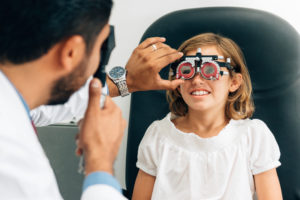September 1, 2022
By Associate Professor Audrey Chia, MBBS (Hons), FRANZCO, PhD
As with any other axial myopia treatment, the child must be seen regularly to monitor progress. Treatment may need to be altered according to response, and once the child reaches their late teenage years, a clinical judgment needs to be made as to whether treatment can be stopped.

In axial or school myopia, myopia progression is associated with eye growth. Eyeball growth occurs through childhood and slows or stabilizes in the late teens. A small change in axial length can result in a relatively significant change in spherical equivalent. It is not unusual that the myopic correction between eyes can be quite different.
Potential clinical scenarios include (i) one eye being hyperopic while the other eye is myopic; (ii) both eyes are myopic, but one is more myopic than another; or (iii) there is a higher progression of myopia in one eye resulting in increased anisometropia over time.
Where there is marked anisometropia in children, it is important to exclude any other pathology that may account for this difference (e.g., glaucoma, lens opacity, dislocation or dysmorphia, or retina problems). One should also exclude any amblyopia or strabismus. This involves taking a good history (e.g., past prematurity, trauma, any syndromic features, family history of any ocular conditions) and a thorough examination (i.e., visual acuity, eye alignment, intraocular pressure, cycloplegic refraction, axial length measurement, anterior and posterior segment examination). If no pathology is noted and spherical equivalents are well correlated to axial length in both eyes, then myopia can be treated as axial.
Many treatments are now available to slow myopia progression, which can be used in isolation or combination. Options include environmental interventions (such as encouraging more outdoor activity, reducing intensive near work, increase ambient light intensities); optical corrections (such as the use of the Hoya MiYOSMART with D.I.M.S. Technology and Essilor Stellest with H.A.L.T. technology spectacles, multizonal contact lenses, or orthokeratology); or atropine eye drops.*
Managing Monocular Myopia
In managing monocular myopia, the same considerations for children with bilateral myopia apply. We know that efficacies can vary with age and race. Younger and East Asian children may progress faster and not respond well to treatment. Also, not all treatments may be suited for all children. For example, optical solutions may not be available for those with very high myopia or astigmatism. Children with sensitive eyes may not tolerate atropine eye drops or contact lenses. The availability or cost of treatments in some countries may limit choice. Not all children can tolerate all treatments as each has potential side effects (e.g., blur, glare, discomfort). Finally, the response to any one treatment can vary between individuals or eyes, and treatment strategies may need to be altered over time. Combination treatments can also be considered.
Also, when there is monocular myopia, the other clinical considerations include whether:
- One should start treatment. It is essential not to simply assume that myopia progression is more significant in the more myopic eye. If past refractions are available, then a review of progression over time can be helpful. In the older child (>12 years old), myopia may already be stable. In the younger child being examined for the first time, one needs to decide if one wishes to monitor for progression. In some young children noted to have very high myopia, the refraction may remain remarkedly stable for some time.
- One should treat both eyes. Some treatments (e.g., environmental or glasses) provide treatment to both eyes. However, with contact lenses or atropine eyedrops, one could vary treatment between eyes. Some may consider allowing the less myopic eye to “catch up” if there is marked anisometropia. Alternatively, one may aim to keep myopia as low as possible in both eyes to decrease the overall risk of future myopic complications. Any subsequent anisometropia during adulthood could be corrected with optical means or refractive surgery.
Should there be concurrent amblyopia and strabismus, this may need to be treated separately. Using myopia-controlling glasses, contact lenses, or eyedrops may, unfortunately, result in some visual degradation, which may worsen amblyopia and strabismus. One may have to weigh the pros and cons of treating one over the other. In most cases, treatment of amblyopia will be a priority over myopia and strabismus.
As with any other axial myopia treatment, the child must be seen regularly to monitor progress. Treatment may need to be altered according to response, and once the child reaches their late teenage years, a clinical judgment needs to be made as to whether treatment can be stopped.
*Most of these treatments are not yet FDA approved for myopia progression control.
|
A graduate of the University of Sydney, Associate Professor Dr. Audrey Chia is currently Head of the Paediatric Ophthalmology and Adult Strabismus Department and Co-Clinical Director of the Myopia Centre at Singapore National Eye Centre (SNEC) and a Senior Consultant at the Eye Centre, KK Women’s and Children’s Hospital, as well as a Senior Clinical Investigator and co-head of the Myopia research unit at the Singapore Eye Research Institute (SERI). |













